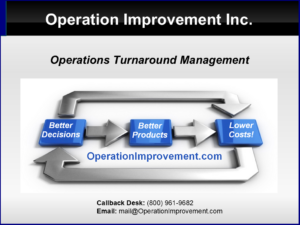How Do You Know…
WHERE TO START
As an improvement consultant, I am asked, “How do you know where to start? How do you zero in on a problem area with a high likelihood that sustainable improvements can be made?”
The answer is in two parts. There is the obvious and familiar starting strategy—follow the money—and then there is a trade secret of rapid improvement.
Following the money simply means auditing the critical path—the sequence of tasks that must be executed in order for the business to get paid. I look for the things you might expect along this path: capacities and bottlenecks, first-pass yields, proper tools for the job, and so on.
But the trade secret of rapid improvement is this:
Look for indecision, uncertainty, and trial-and-error behavior.
Now, let me stress that this is not the problem. It is a symptom or warning flag, an X that marks exactly the spot on the business-critical path where one should dig for treasure. Improvement is not simply achieved by squashing disagreement and reckless boldness that pretends to be certainty.
I have tracked these revealing clues through all kinds of processes: call centers, accounting operations, technology infrastructure, and manufacturing. One of the clearest illustrations that trial-and-error behavior denotes a serious process problem is the story of one client’s metal machining operation.
THE STORY OF THE EIGHT STATION
This manufacturing plant had everything, from computer-controlled cutting equipment (CNC machines) to high-end finishing equipment designed for tolerances better than 100 millionths of an inch.
The natural interest of the engineers was the complex CNC devices and the high-precision finishing tools, but in this facility there was a big payoff opportunity that had not been discovered.
An inexpensive series of low-tech workstations prepared every single metal casting before it went into the CNC or finish-work processes. The centerpiece of this line was called the eight-station. Designed for low cost and maximum throughput, the heart of this workstation was a turntable on which eight unworked metal castings were placed at forty-five-degree intervals.
The table would make a one-eighth turn, and each of seven machining stations would simultaneously make their specific cuts. Station #8 was for the operator who loaded and unloaded parts.
It was soon obvious to me that this particular operation was a den of confusion. The operators called it the machine from hell. “Only Johnny can set it up, and it takes hours,” they said.
As I watched, I quickly saw why the machine was so difficult to set up.
- Eight fixtures for holding parts must be bolted onto the turntable.
- They could be placed too close or too far from the center of the table.
- They could be placed too far to the left or to the right.
- Two degrees of freedom times eight fixtures equals sixteen different adjustments that must be exactly right.
There was more.
- The operators had to unbolt and lever the machining stations into position.
- Seven movable machining stations meant fourteen more dimensions to the problem.
- There was a grand total of 30 independent but interrelated dimensional adjustments that had to be brought into harmony before the machine was set correctly.
I watched as Johnny, the best operator in the house, struggled for hours to get all the pieces of this machine into position. Tweaking the setup by trial and error, one adjustment always led to a dozen readjustments.
A trial run meant wasting raw material by making sample cuts that were sent to the measurement lab for evaluation. It was usually fatigue and an urgent demand for production that forced him to surrender the effort and attempt to produce a product.
THE SOLUTION
I took a little time to think about the problem. How should the setup of this machine be handled? When I thought I had the answer, I went back to Johnny.
“Tell me,” I asked, “is there anything on this machine you won’t move to make a correct setup?”
Johnny answered, “Well, the engineers told me that I should try not to move the stations on the left and right of the operator position. They didn’t know why. I tried to leave them alone but I’ve had to move them anyhow.”
His answer confirmed my suspicions. The machine’s designer had intended that two of the workstations, together with the center of the turntable, form a perfect ninety-degree angle.
Those three points would establish the absolute reference frame from which every component could easily and systematically be placed in its one and only correct position.
Once this carpenter’s square had been broken, the machine could no longer be set up with certainty. There was no longer one and only one place to position any component.
The solution was:
- Re-establish the permanent location of the two machining stations on either side of the operator by precision measurement.
- Teach the operators that the setup process must be remembered as an ABC sequence that must be followed carefully and in order.
a) The built-in 90-degree reference angle must never be altered. It shows where to exactly place fixtures.
b) All fixtures are systematically placed on the turntable underneath the two permanently positioned machining workstations on either side of the operator. The table is turned, and then all placed fixtures then determine the one and only place for the remaining five movable machining workstations.
c) The remaining five workstations are positioned last, after every fixture has been placed on the table and carefully aligned with the immovable workstations on either side of the operator.
There were some optional elements to this improved setup, but it was no longer trial and error. Instead, it was now a consistent process with a predictable duration and a certain outcome.
THE REST OF THE STORY
The rest of the story has to answer one big question.
What drove the operators to break the rule and move the two forbidden machine stations?
First of all, no one in the plant truly understood the significance of those two stations on either side of the operator.
A perfect 90-degree angle establishes a repeatable frame of reference for measurement.
Although operators were directed to never move two of the machining workstations, they later received directions that created a conflict.
A reliance on obedience to procedure combined with an absence of process knowledge is a risky thing. If there are two orders to obey, and the orders appear to conflict, then what will happen?
Without process knowledge, the outcome is left to chance.
Secondly, the conflict was created by a fundamental flaw in management’s setup decision rules.
How do you know when a setup is correct? The flawed decision rule said, “A sample cut must be made and compared to specifications.”
The proper decision rule for “correct” is, “When you have audited and are certain that you have adhered to every aspect of a correct setup process.” It is engineering’s responsibility to see that a correct process will produce the intended product.
In this plant, setup was deemed to be wrong if a sample part failed a QC measurement check. (Imagine a math teacher who only checks answers and not how the answer was computed!)
This plant’s setup policy was additionally flawed because of the assumption that a single selected sample will always be average.
Questionable measurement precision of sample product in this plant compounded the problem and drove operators to a point where they felt they had no alternative but to break the machine to gain setup approval.
FOOTNOTE FOR THE MECHANICAL ENGINEER:
Pinning this machine was not the solution and only added constraints that made it impossible to correct the problem.
After the reference angle was broken, the engineering department had tried to sort out the mess by welding positioning pins to the turntable. They deprived the setup operator of the ability to make necessary adjustments and therefore made matters worse.
Copyright © 2025 Operation Improvement Inc. All rights reserved.





